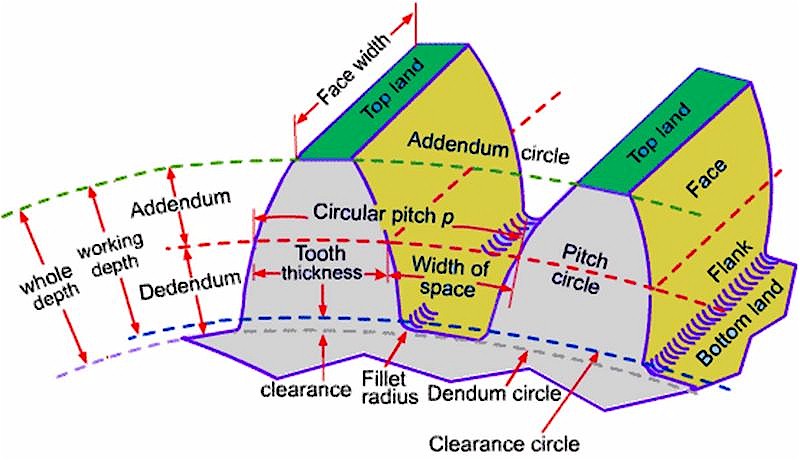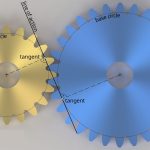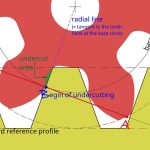Figure 7-4 shows some of the terms for gears.

Figure 7-4 Spur Gear
In the following section, we define many of the terms used in the analysis of spur gears. Some of the terminology has been defined previously but we include them here for completeness. (See (Ham 58) for more details.)
- Pitch surface : The surface of the imaginary rolling cylinder (cone, etc.) that the toothed gear may be considered to replace.
- Pitch circle: A right section of the pitch surface.
- Addendum circle: A circle bounding the ends of the teeth, in a right section of the gear.
- Root (or dedendum) circle: The circle bounding the spaces between the teeth, in a right section of the gear.
- Addendum: The radial distance between the pitch circle and the addendum circle.
- Dedendum: The radial distance between the pitch circle and the root circle.
- Clearance: The difference between the dedendum of one gear and the addendum of the mating gear.
- Face of a tooth: That part of the tooth surface lying outside the pitch surface.
- Flank of a tooth: The part of the tooth surface lying inside the pitch surface.
- Circular thickness (also called the tooth thickness) : The thickness of the tooth measured on the pitch circle. It is the length of an arc and not the length of a straight line.
- Tooth space: The distance between adjacent teeth measured on the pitch circle.
- Backlash: The difference between the circle thickness of one gear and the tooth space of the mating gear.
- Circular pitch p: The width of a tooth and a space, measured on the pitch circle.
- Diametral pitch P: The number of teeth of a gear per inch of its pitch diameter. A toothed gear must have an integral number of teeth. The circular pitch, therefore, equals the pitch circumference divided by the number of teeth. The diametral pitch is, by definition, the number of teeth divided by the pitch diameter. That is,
![]() (7-5)
(7-5)
and
![]() (7-6)
(7-6)
Hence
![]() (7-7)
(7-7)
where
p = circular pitch
P = diametral pitch
N = number of teeth
D = pitch diameter
That is, the product of the diametral pitch and the circular pitch equals ![]() .
.
- Module m: Pitch diameter divided by number of teeth. The pitch diameter is usually specified in inches or millimeters; in the former case the module is the inverse of diametral pitch.
- Fillet : The small radius that connects the profile of a tooth to the root circle.
- Pinion: The smaller of any pair of mating gears. The larger of the pair is called simply the gear.
- Velocity ratio: The ratio of the number of revolutions of the driving (or input) gear to the number of revolutions of the driven (or output) gear, in a unit of time.
- Pitch point: The point of tangency of the pitch circles of a pair of mating gears.
- Common tangent: The line tangent to the pitch circle at the pitch point.
- Line of action: A line normal to a pair of mating tooth profiles at their point of contact.
- Path of contact: The path traced by the contact point of a pair of tooth profiles.
- Pressure angle
 : The angle between the common normal at the point of tooth contact and the common tangent to the pitch circles. It is also the angle between the line of action and the common tangent.
: The angle between the common normal at the point of tooth contact and the common tangent to the pitch circles. It is also the angle between the line of action and the common tangent. - Base circle :An imaginary circle used in involute gearing to generate the involutes that form the tooth profiles.
Table 7-1 lists the standard tooth system for spur gears.

Table 7-1 Standard tooth systems for spur gears



Comments are closed